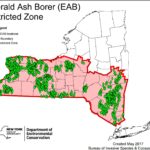Logging Ash to Save Hemlock
Facing the inevitable invasion of emerald ash borer (EAB), The Nature Conservancy in Pennsylvania chose to harvest its ash trees for cash and reinvest the profits in saving its hemlocks. Landowners in New York may face similar choices as the ash borer continues its spread.
 New York DEC has recently expanded and merged the quarantine zone for EAB to a significant portion of the state including the entire Finger Lakes PRISM. Within this area ash wood, logs, firewood, nursery stock and wood chips can be moved freely (subject to the 50-mile firewood restriction) . It cannot be moved outside of the restricted zone without a permit. See the DEC site for details.
New York DEC has recently expanded and merged the quarantine zone for EAB to a significant portion of the state including the entire Finger Lakes PRISM. Within this area ash wood, logs, firewood, nursery stock and wood chips can be moved freely (subject to the 50-mile firewood restriction) . It cannot be moved outside of the restricted zone without a permit. See the DEC site for details.
This is intended to slow or stop the spread of EAB to the uninfected areas of the state because EAB does not travel far on its own. However, within the zone, the spread of EAB is likely to be unimpeded. For example, it was recently discovered in Tompkins County and the city of Ithaca.
Uninfected ash has commercial value and can also be treated. But treatment is expensive and isn’t practical on a large-scale basis, costing in the range of $100-200 per tree per year. If EAB infestation is inevitable, then hard decisions need to be made. With 76% of New York’s forests owned by private landowners, they are going to have to make these decisions. A recent article in the PrairieFarmer laid out the options faced by landowners in clear terms: treat or cut down.
Using the Pennsylvania example, harvesting the ash can fund treatment for other priority trees, including hemlock which is facing the invasion of hemlock woolly adelgid. There are still areas of the Finger Lakes PRISM which are not infected by EAB, but time is running out.




